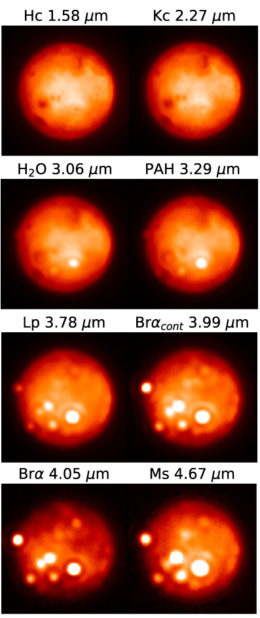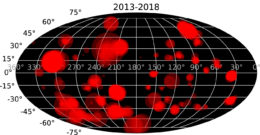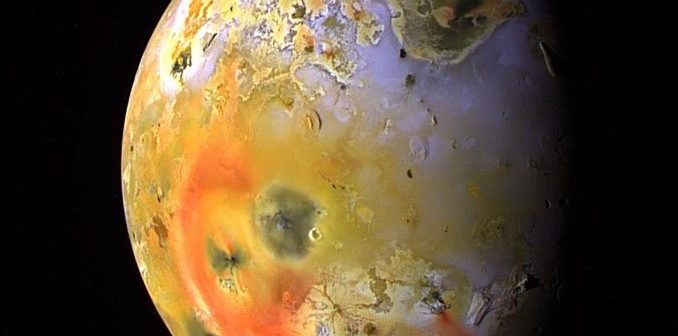For all that space telescopes are powerful tools for exploring our universe, we can achieve some remarkable science using ground-based observations! A new study explores the lessons learned from five years of monitoring Jupiter’s volcanic moon Io from the ground.

This set of images from Keck, all taken within 30 minutes of each other, demonstrates the range of filters used to observe Io during this campaign. [de Kleer et al. 2019]
A Dramatic Landscape
Jupiter’s innermost moon, Io, is a dramatic, roiling world of heated activity. The moon’s not-quite-circular orbit means that it receives a varying gravitational tug from Jupiter, generating friction and warming up the moon’s interior. This heat then escapes from Io’s surface in the form of active volcanic vents, tremendous explosions, and scalding lava flows.
Continuous monitoring of all of these activities — Io’s hotspots, or locations of thermal emission — is essential to understand how heat is dissipated in this violently active moon. We’ve had the opportunity to explore Io’s volcanism up close as the Voyager, Galileo, Cassini, and New Horizons missions have each passed by the moon, revealing more than 150 active volcanoes on Io’s surface. But these brief flybys don’t provide the important long-term, high-cadence observations of Io’s hotspots needed to truly track its activity.
Luckily, space-based astronomy is not the only solution!
View from the Ground
Over the last five years, scientists have carefully monitored Io’s thermal emission using the Keck and Gemini North telescopes located in Hawaii.
Think their observations couldn’t possibly be as useful as the up-close data from space telescopes? Think again! The powerful adaptive optics on Keck and Gemini North allowed the team to resolve down to distances of 100–500 km on Io’s surface in infrared— a scale not far from the resolution attained by the Near-Infrared Mapping Spectrometer on Galileo during its flybys.
What’s more, the flexible scheduling of Gemini North and a dedicated observing program at Keck made it possible for the team to gather 271 nights of observations of Io over 5 years. In a new study led by Katherine de Kleer (California Institute of Technology), the team now details what they’ve learned from this campaign.
Lessons from Hotspots

Spatial distribution of hotspot thermal emission detected on Io in 2013–2018. [de Kleer et al. 2019]
- The brightest eruptions are generally short-lived (lasting only a few days) and very hot (above 800 K, or nearly 1,000°F). They also almost all cluster in Io’s trailing hemisphere — the side of the moon located away from its direction of motion. This trend remains unexplained.
- A number of new hotspots have only been detected in the past three years. Some of these likely existed before but only emit sporadically; others may have arisen more recently.
- 113 detections of the extremely active Loki Patera hint at a periodicity to this volcano of ~470 days — behavior that could be tied to Io’s orbital properties.
The authors have made all of their hotspot data available for public download and invite the astronomy community to extend their work. Between future analysis of these data and further observations of Io, we can certainly look forward to more insights into this heated, dynamic world.
Citation
“Io’s Volcanic Activity from Time Domain Adaptive Optics Observations: 2013–2018,” Katherine de Kleer et al 2019 AJ 158 29. doi:10.3847/1538-3881/ab2380

1 Comment
Pingback: Pesquisadores Usam Telescópios Em Terra E Estudam Por 5 Anos Os Vulcões de Io | Mestre Jedi